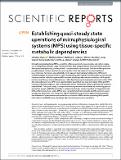| dc.contributor.author | Dallas, Matthew | |
| dc.contributor.author | Stokes, Cynthia L. | |
| dc.contributor.author | Maass, Christian Alexander | |
| dc.contributor.author | LaBarge, Matthew E | |
| dc.contributor.author | Shockley, Michael J | |
| dc.contributor.author | Valdez Macias, Jorge Luis | |
| dc.contributor.author | Geishecker, Emily R | |
| dc.contributor.author | Griffith, Linda G | |
| dc.contributor.author | Cirit, Murat | |
| dc.date.accessioned | 2018-09-04T16:51:07Z | |
| dc.date.available | 2018-09-04T16:51:07Z | |
| dc.date.issued | 2018-05 | |
| dc.date.submitted | 2017-12 | |
| dc.identifier.issn | 2045-2322 | |
| dc.identifier.uri | http://hdl.handle.net/1721.1/117618 | |
| dc.description.abstract | Microphysiological systems (MPS), consisting of tissue constructs, biomaterials, and culture media, aim to recapitulate relevant organ functions in vitro. MPS components are housed in fluidic hardware with operational protocols, such as periodic complete media replacement. Such batch-like operations provide relevant nutrients and remove waste products but also reset cell-secreted mediators (e.g. cytokines, hormones) and potentially limit exposure to drugs (and metabolites). While each component plays an essential role for tissue functionality, MPS-specific nutrient needs are not yet well-characterized nor utilized to operate MPSs at more physiologically-relevant conditions. MPS-specific nutrient needs for gut (immortalized cancer cells), liver (human primary hepatocytes) and cardiac (iPSC-derived cardiomyocytes) MPSs were experimentally quantified. In a long-term study of the gut MPS (10 days), this knowledge was used to design operational protocols to maintain glucose and lactate at desired levels. This quasi-steady state operation was experimentally validated by monitoring glucose and lactate as well as MPS functionality. In a theoretical study, nutrient needs of an integrated multi-MPS platform (gut, liver, cardiac MPSs) were computationally simulated to identify long-term quasi-steady state operations. This integrative experimental and computational approach demonstrates the utilization of quantitative multi-scale characterization of MPSs and incorporating MPS-specific information to establish more physiologically-relevant experimental operations. | en_US |
| dc.description.sponsorship | United States. Defense Advanced Research Projects Agency. Microphysiological Systems Program (W911NF-12-2-0039) | en_US |
| dc.description.sponsorship | National Institutes of Health (U.S.) (U24TR001951) | en_US |
| dc.description.sponsorship | National Institutes of Health (U.S.). Microphysiological Systems Program (4-UH3-TR000496-03) | en_US |
| dc.publisher | Nature Publishing Group | en_US |
| dc.relation.isversionof | http://dx.doi.org/10.1038/s41598-018-25971-y | en_US |
| dc.rights | Creative Commons Attribution 4.0 International License | en_US |
| dc.rights.uri | http://creativecommons.org/licenses/by/4.0/ | en_US |
| dc.source | Nature | en_US |
| dc.title | Establishing quasi-steady state operations of microphysiological systems (MPS) using tissue-specific metabolic dependencies | en_US |
| dc.type | Article | en_US |
| dc.identifier.citation | Maass, Christian, Matthew Dallas, Matthew E. LaBarge, Michael Shockley, Jorge Valdez, Emily Geishecker, Cynthia L. Stokes, Linda G. Griffith, and Murat Cirit. “Establishing Quasi-Steady State Operations of Microphysiological Systems (MPS) Using Tissue-Specific Metabolic Dependencies.” Scientific Reports 8, no. 1 (May 22, 2018). | en_US |
| dc.contributor.department | Massachusetts Institute of Technology. Biotechnology Process Engineering Center | en_US |
| dc.contributor.department | Massachusetts Institute of Technology. Department of Biological Engineering | en_US |
| dc.contributor.department | Massachusetts Institute of Technology. Department of Mechanical Engineering | en_US |
| dc.contributor.mitauthor | Maass, Christian Alexander | |
| dc.contributor.mitauthor | LaBarge, Matthew E | |
| dc.contributor.mitauthor | Shockley, Michael J | |
| dc.contributor.mitauthor | Valdez Macias, Jorge Luis | |
| dc.contributor.mitauthor | Geishecker, Emily R | |
| dc.contributor.mitauthor | Griffith, Linda G | |
| dc.contributor.mitauthor | Cirit, Murat | |
| dc.relation.journal | Scientific Reports | en_US |
| dc.eprint.version | Final published version | en_US |
| dc.type.uri | http://purl.org/eprint/type/JournalArticle | en_US |
| eprint.status | http://purl.org/eprint/status/PeerReviewed | en_US |
| dc.date.updated | 2018-08-30T17:03:21Z | |
| dspace.orderedauthors | Maass, Christian; Dallas, Matthew; LaBarge, Matthew E.; Shockley, Michael; Valdez, Jorge; Geishecker, Emily; Stokes, Cynthia L.; Griffith, Linda G.; Cirit, Murat | en_US |
| dspace.embargo.terms | N | en_US |
| dc.identifier.orcid | https://orcid.org/0000-0002-6673-087X | |
| dc.identifier.orcid | https://orcid.org/0000-0002-1801-5548 | |
| mit.license | PUBLISHER_CC | en_US |
